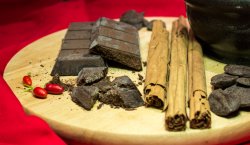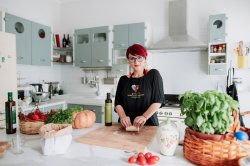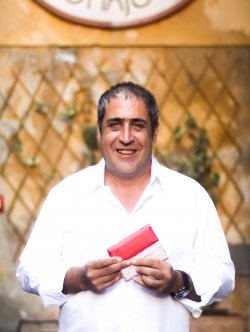Aztec Chocolate in Sicily: An online cooking lesson presented by Annalisa Pompeo
Introduction to the history of the Aztec chocolate in Modica by Pierpaolo Ruta
Moderated by Teresa Fiore (Inserra Chair, Montclair State University)
Closing remarks by Floriana Di Gesù (Università degli Studi di Palermo)
Monday April 19, 2021 11:00am EST / 17 ora italiana – FLYER
Zoom webinar presented in Italian with simultaneous interpretation into Spanish (Giampaolo Sponza and Raffaello Dal Col) and English (Lilia Pino Blouin e Maria Galetta) – Instructions for interpretation
The lesson focuses on a chocolate bar that is still being manufactured both in Mexico and Modica (Sicily) using exactly the same techniques, and that was originally developed by the Aztecs and brought to Sicily by the Spaniards. After a brief historical introduction, chef Annalisa Pompeo will walk the participants through the preparation of the Aztec chocolate bar. She will illustrate the main recipe which includes the use of a palette of flavors ranging from traditional ingredients such as cinnamon and chili pepper to more contemporary ones.
For questions, please contact the chef.
Aztec chocolate is one of the several foods introduced into Southern Italy gastronomy during the Spanish imperial period. A collection of recipes is under way in collaboration with Annalisa Pompeo as part of a project aimed at exploring the common Spanish legacy in Italian and Latin American cultures, now supported by an NEH Award in connection to the course Italian for Spanish Speakers.
Pierpaolo Ruta is the sixth-generation manager of the oldest chocolate factory in Sicily, Antica Dolceria Bonajuto. He lives and works in Modica. For over thirty years he has been engaged in researching the “stone-based” (alla pietra) chocolate production and its routes from Mesoamerica to Europe, and Sicily in particular.
Floriana Di Gesù is Associate Professor in Spanish Language and Translation in the Department of Letters and Philosophy of the University of Palermo. She is also the President of the Language Center (CLA) and the director of the dual degree program in Language and Translation for International Relations (University of Palermo) and Translation for Creative Writing and the Humanities of the University of Valencia (Spain).
- Designed in connection with the course project Italian for Spanish Speakers offered at MSU since 2019, and in collaboration with the Dipartimento di Facoltà di Lettere e Filosofia di Palermo (Lingua e Traduzione Spagnola), as part of a virtual exchange program (COIL) focusing on intercultural and interlanguage acquisition (Italian for Spanish speakers and Spanish for Italian speakers).
- Included in the new series “Dentro/Afuera: The Interconnections between Italian and Latin American/Spanish Cultures”
- Linked to the Italian Program (Department of World Languages and Cultures) and in collaboration with the Department of Nutrition and Food Studies at MSU
- Short link for this page: http://tinyurl.com/Aztechoco
RESOURCES:
“The Italian Town with an Ancient Secret” By Lucinda Hawksley (BBC Travel, 2015)
“A Chocolate Tradition Thrives in Sicily” by Kate Singleton. New York Times (1999).
Ferdinando Scianna reads an excerpt from his book Ti mangio con gli occhi (Contrasto, 2013) about his encounter with a chocolate in Oaxaca, Mexico that smelled exactly like the one in Sicily (in Italian):



